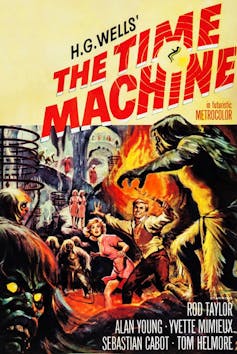Lifestyle
A college course that’s a history of the future
The course “Science Fiction as Intellectual History” explores how sci-fi reflects cultural thoughts and anxieties, using stories to analyze technology, future predictions, and evolving societal ideas.

Adam Jortner, Auburn University
Uncommon Courses is an occasional series from The Conversation U.S. highlighting unconventional approaches to teaching.
Title of course:
Science Fiction as Intellectual History
What prompted the idea for the course?
For most of its history, science fiction was a disreputable, throwaway genre. But sources of culture and thought aren’t just found in classic literature or in the writings of the great thinkers. They’re also in popular entertainment: movies, comics, pulp magazines, TV.
Big thoughts often come in chunks with labels like “The Future” or “Technology” or “Freedom.” And most ideas about these things are shaped by science fiction.
So in this class, my students explore how the theories of Charles Darwin, for example, are reflected in science fiction like “Jurassic Park,” “The Island of Dr. Moreau,” “X-Men” and “The Wrath of Khan.”
I’m lucky to be the third generation of professors teaching this course at Auburn. It’s an old staple here that I inherited.
What does the course explore?
I usually pick three big plot ideas from sci-fi: alien encounters, time travel and superhuman abilities. Then we trace the development of those ideas, primarily through American fiction.
Students might read H.G. Wells’ “The Time Machine,” which was written in the 1890s and tells the story of the Eloi and Morlocks, post-human races from 800,000 years in the future; C.L. Moore’s secret visitors from the future in the 1953 novella “Vintage Season”; and Steven Spielberg’s 1985 escape to an idealized 1950s in “Back to the Future.”
These works all include mind-bending theories about what time travel might look like. But students also see how each of them tells a different story about the anxieties and obsessions of the times in which they were created.
For example, Wells’ novel is a vision of how thousands of years of Victorian class divisions lead to the evolution of a group of cannibalistic underground humans. In “Back to the Future,” Marty McFly leaves the dingy, broken-down 1980s for a clean and shiny version of the 1950s, one that looks much more promising than 1985. The film taps into the 1980s political and cultural nostalgia for so-called “simpler” times. (Of course, in their version of 1955, Biff and Marty never deal with segregation or Cold War nuclear panic.)
Science fiction offers a kind of film negative of history – a back door into what made people worried or scared rather than what was heroic. Sci-fi captures that fear and anxiety.
Rod Serling’s 1960 “Twilight Zone” episode “The Monsters Are Due on Maple Street” is the story of how neighbors turn on each other when they suspect an alien invasion is taking place. It parallels the American crisis over desegregation and communist subversion.
As Serling concluded, “For the record, prejudices can kill and suspicion can destroy, and a thoughtless, frightened search for a scapegoat has a fallout of its own – for the children, and the children unborn. And the pity of it is that such things cannot be confined to the Twilight Zone.”
Why is this course relevant now?
New technology, along with endless predictions and prophecies about the future, bombard students.
It’s important to take a moment to step back. How is the way we talk about and use technology influenced by the way we’re trained to think about technology and the future? And how much do past visions of the future dictate the choices of the present?
What’s a critical lesson from the course?
Students often think technology has rules and it will follow those rules. But technology doesn’t work like that.
That’s both terrifying and uplifting, because it means that we can still create and imagine our future as we see fit.
What materials does the course feature?
I anchor the course with a series of novels; the list changes, but it always includes “The Time Machine” and Ursula K. Le Guin’s 1971 novel “The Lathe of Heaven.”
Beyond that, I try to pepper in a mix of pulp stories, TV shows, radio dramas, comic books and films. I assign the 1970s avant-garde sci-fi stories of Brian Aldiss and Joanna Russ, and underground literature from the 1980s, such as the graphic novel “Ed the Happy Clown.”
I shape the course like a traditional “great books” course – those that feature the works of intellectual and literary giants – by assigning a different work every week. I just have a different idea about what makes a great book.
We also spend a delightful week examining the economic and cultural history of “so-bad-its-good” B movies and late-night features, where I have them watch an episode of the Canadian sci-fi show “The Starlost,” considered one of the worst shows in television history. Sometimes you have to learn what not to do.
What will the course prepare students to do?
They learn to read and think. They learn that all stories have ideas and philosophies, whether simple or complex, wise or foolish.
I hope they learn to watch for nonsense in public debates about technology and the future – like how some people assume computer modeling for human language is the same thing as language – and keep an eye out for ideologies masquerading as action films.
I hope they learn to love an author they’ve never read before – and learn to appreciate how much reading and stories make life worth living.
Adam Jortner, Goodwin Philpott Eminent Professor of Religion, Auburn University
This article is republished from The Conversation under a Creative Commons license. Read the original article.
Our Lifestyle section on STM Daily News is a hub of inspiration and practical information, offering a range of articles that touch on various aspects of daily life. From tips on family finances to guides for maintaining health and wellness, we strive to empower our readers with knowledge and resources to enhance their lifestyles. Whether you’re seeking outdoor activity ideas, fashion trends, or travel recommendations, our lifestyle section has got you covered. Visit us today at https://stmdailynews.com/category/lifestyle/ and embark on a journey of discovery and self-improvement.
Discover more from Daily News
Subscribe to get the latest posts sent to your email.
Consumer Corner
Reduce, Reuse, Rejoice: 5 Holiday Hacks for Eco-Friendly Celebrations
Discover 5 simple holiday hacks to reduce waste and celebrate sustainably. Learn how to plan meals, recycle food scraps, give greener gifts, and properly sort holiday waste while saving money this season.
Last Updated on December 5, 2025 by Daily News Staff

Reduce, Reuse, Rejoice: 5 Holiday Hacks for Eco-Friendly Celebrations
(Family Features) Holiday celebrations bring joy, laughter and lasting memories – but they can also leave behind a sleigh full of waste. From food scraps and empty bottles to wrapping paper and decorations, the season can leave your home full of items that could be reused or recycled. In fact, household waste increases nearly 25% between Thanksgiving and New Year’s Day, according to survey results from the Center for Biological Diversity. That’s a lot of leftovers, garland and glass that could be kept out of landfills. To help you cut down on trash and embrace a joyful, less-waste holiday season, the experts at CalRecycle offer these five holiday hacks to help you save cash and protect the planet.- Plan Meals to Waste Less and Save More
- Shop your pantry first to avoid buying what you already have.
- Buy only what you need and prepare recipes based on guest count.
- Choose local ingredients from sources like farmers markets that minimize packaging.
- Send guests home with leftovers in reusable containers or freeze extras for future meals.
- Recycle Food Scraps
- Not all food can be saved, but it doesn’t have to go in the trash.
- Compost fruit and vegetable trimmings, eggshells, coffee grounds and plate scrapings. Trashed food makes climate pollution in landfills. Recycle it in your green bin instead.
- Most California communities now offer green bin composting. Learn what goes in the green bin by visiting the Curb Your Food Scraps page on RecyclingReimaginedCA.com.
- Set out a clearly labeled “food scraps” bin next to your trash, as well as a recycling bin for bottles, cans and other containers so everyone can participate.
- Eat, Drink and Be Eco-Friendly
- Use reusable plates, cups and utensils instead of disposable options.
- Decorate with items you can use year after year or make compostable decor from natural materials.
- Collect empty wine, liquor, juice or other California Redemption Value (CRV)-eligible containers and cash them in once the party is over.
- Serve water in reusable pitchers or carafes instead of single-use plastic bottles.
- Give Greener Gifts
- Choose experiences over stuff, like tickets to events, museum or club memberships, registrations for classes or shared adventures.
- Wrap gifts in fabric, scarves or reusable tins. Or use recyclable paper without glitter or foil.
- Personalize presents with homemade crafts, baked goods or services that reduce packaging.
- Prioritize gifts from local and sustainable businesses that are committed to ethical sourcing, minimal packaging and recycled materials.
- Sort Holiday Waste the Right Way
- After the celebrations, check local recycling rules for how to properly dispose of:
- Batteries
- Holiday lights
- Christmas trees
- Drop off CRV-eligible beverage containers, such as wine and spirit containers, at your nearest recycling site for cash back.
- Donate unwanted gifts or gently used holiday items to local charities or thrift stores.
Our Lifestyle section on STM Daily News is a hub of inspiration and practical information, offering a range of articles that touch on various aspects of daily life. From tips on family finances to guides for maintaining health and wellness, we strive to empower our readers with knowledge and resources to enhance their lifestyles. Whether you’re seeking outdoor activity ideas, fashion trends, or travel recommendations, our lifestyle section has got you covered. Visit us today at https://stmdailynews.com/category/lifestyle/ and embark on a journey of discovery and self-improvement.
Discover more from Daily News
Subscribe to get the latest posts sent to your email.
Family
5 Trending Holiday Looks for the Whole Family
Creating trendy ensembles when you just want to stay warm can be a challenge, but this season’s hottest looks make it easy to keep cozy while dressing up or down.
Last Updated on December 3, 2025 by Daily News Staff
(Family Features) Creating trendy ensembles when you just want to stay warm can be a challenge, but this season’s hottest looks make it easy to keep cozy while dressing up or down. Whether you’re aiming for style for a holiday celebration or planning an evening out to shop and take in the holiday lights, this season’s trends have you covered.
Stylish layers and updates to winter wardrobe staples are two keys to nailing this season’s on-trend looks, according to acclaimed American fashion designer Brandon Maxwell, who is collaborating with Walmart as creative director for Free Assembly and Scoop, the retailer’s exclusive, elevated fashion brands.
“Like many people across the country who live in a small town, Walmart was the destination for everything where I grew up, including holiday fashion,” Maxwell said. “When I first teamed up with Walmart, I was excited to bring the joy of fashion to people across the country. Everyone deserves to enjoy their holidays in clothing they love. This year, we are proud to offer the biggest trends in holiday fashion, from cozy outwear to glamorous party looks.”
Maxwell offers these tips for creating the perfect affordable look, no matter where your plans take you this winter:
Metallic Shine: Metallic sweater sets, like a boxy crewneck and matching mini skirt in a glitzy gold shade, are must-have pieces for the holidays. Wear the show-stopping set with matching gold earrings and platform sandals for a head-turning party look.
Layers of Style: Layer festive multicolor patterns in intarsia knits like this Free Assembly fair isle sweater with a plaid puffer jacket for an easy update to winter closet staples like lightly distressed jeans and booties.
Party Perfect: Sophisticated outerwear pieces like a double-breasted coat add a modern touch to classic holiday party looks. Pair with a berry-hued mini dress, black tights and black boots for a look that stands out. For a bit of edge, choose a faux moto jacket layered over a sequin cami top or metallic sweater to complement a faux leather skirt.
Casual Comfort: This season, menswear is all about intentional layering and looks that prioritize both comfort and style. Update vintage-inspired flannels by layering with a quilted puffer pullover and matching them with wintry prints and cargo joggers for a look that’s casual and put together all at once.
Little Lookers: Fashionable little ones can also get decked out this season. Colorful sparkly girl’s dresses from Scoop perfectly complement matching versions for women, ideal for family photos and mommy-and-me moments that make the season extra special. For a more casual event, fair isle sweater dresses in fun shades like lavender can make a classic look oh-so-now.
Find more festive fashion inspiration by visiting Walmart.com.
SOURCE:
Walmart
Discover more from Daily News
Subscribe to get the latest posts sent to your email.
Blog
The Substitute Teacher Who Wanted Blueprints of Our House
A fifth-grade assignment took a strange turn when a substitute teacher asked students to draw schematics of their homes. What followed — a wildly fictional floor plan and a priceless reaction from my mom — turned into one of my funniest childhood memories.
Last Updated on December 3, 2025 by Daily News Staff
The Substitute Teacher Who Wanted Blueprints of Our House
Elementary school memories tend to blend together — cafeteria pizza, playground arguments, the eternal struggle of times tables — but every once in a while, something happens that sticks with you for life. For me, that moment came in the fifth grade during a week when our regular teacher was out, and we cycled through substitute teachers like we were testing models for durability. By midweek, in walked a substitute with a mysterious, slightly intense energy — the kind of vibe that suggested he either meditated at dawn or worked a graveyard shift doing something he couldn’t talk about. We settled into our seats, expecting worksheets or quiet reading time. But nope. He had other plans. “Today,” he announced, “we’re going to draw schematics of our houses.” Schematics. Not drawings. Not little houses with smoke coming out of the chimney. Actual blueprint-style schematics. He wanted the layout of our bedrooms, our parents’ rooms, and where the pets slept. Every detail. Now, to be fair, Highlights Magazine did have a feature that month teaching kids how to draw floor plans. So maybe he was just a bit overenthusiastic about cross-curricular learning. Or maybe — and this is my completely rhetorical adult theory — he worked the graveyard shift as a cat burglar gathering intel between heists. Just moonlighting between blueprints. While the rest of the class tried their best to recreate their actual homes, my imagination sprinted in a totally different direction. The house I drew had:- A massive master bedroom with an oversized bathroom for my parents
- Separate bedrooms for us kids on the opposite side of the house
- A kitchen placed right in the center like a command center
- And the dog — the true VIP — had a luxurious two-story doghouse
Enjoy this story?
Check out more nostalgic and humorous stories on STM Daily News and be sure to sign up for our newsletter!Our Lifestyle section on STM Daily News is a hub of inspiration and practical information, offering a range of articles that touch on various aspects of daily life. From tips on family finances to guides for maintaining health and wellness, we strive to empower our readers with knowledge and resources to enhance their lifestyles. Whether you’re seeking outdoor activity ideas, fashion trends, or travel recommendations, our lifestyle section has got you covered. Visit us today at https://stmdailynews.com/category/lifestyle/ and embark on a journey of discovery and self-improvement.
Discover more from Daily News
Subscribe to get the latest posts sent to your email.
